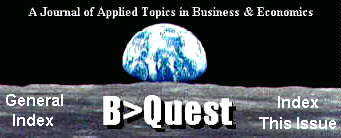|
|
|
November 27, 2002 |
|
|
|
November 27, 2002 |
When
Federal Reserve Chairman Alan Greenspan said that the United States hit a
"slow patch," was this unusual or something that often happens in
the early stages of an economic rebound?
Let
us review the dimensions of this slowing. Employment is falling and so are
weekly
Furthermore,
the leading indicators have a string of consecutive declines behind them. If
the stock market had not begun to rally from its October 9 lows, most
economists would worry about the onset of renewed weakness.
Frankly,
the dimensions of this "slow patch" are unusual. My measures suggest
that GDP actually declined in October and will show only modest gains for the
fourth quarter. My estimate of Christmas sales is only 3.5 percent growth,
well short of the 5.6 percent gains reported last year.
Nevertheless,
a pause after the first burst of rebound is not unusual.
Whatever
initiated a typical recession, falling paychecks ultimately push spending
below production,
and inventories jump. To remove those inventories, production lines are turned
off while goods are sold from the warehouses.
Once
the warehouses begin to empty, production slowly picks up. This normally leads
to overtime hours and some renewed hiring. The result is rising purchasing
power along with higher production. Indeed, this early phase of a rebound
usually shows above normal rates of growth. (Five percent GDP growth in the
first quarter of 2002 was the result of this process.)
At
some point, the amount of inventory, current production, and sales are
restored to some balance. This is normally where a rebound suffers a pause.
Also,
recessions normally cause consumers to delay replacement of autos and
appliances. Housing slows because falling paychecks more than offset falling
mortgage rates. When the recovery begins, these deferred purchases reappear.
Thus, housing and auto sales usually are still surging upward when inventories
are restored to balance with sales.
Thus,
the pause in industrial activity usually is not very long.
Because
of aggressive interest rate reductions during the latest recession, however,
autos and housing began rebounding even while paychecks were falling and
inventories were spinning out of balance. By the time the pause caused by
restoration of inventory balance occurred, housing and autos were stabilizing
from their own rebounds.
Of
course, the interest rate declines shortened and diminished the magnitude of
the recession, but it also lengthened and intensified the pause after the
inventory rebound. That is where this economy is now.
Can
the pause undermine confidence and push the economy back into recession. This
did occur in 1960 (following the 1958 recovery) and 1982 (after the 1980
plunge and rebound). However, both those "double dips" were
accompanied by restrictive government spending policies and monetary
restraint.
With
government spending up 8 percent in the past year, money growth near double
digit rates, interest rates at 40 year lows, and $130 billion of reduced tax
liability facing households in the past year, this is not likely to develop
into another "double dip."
Certainly,
the Federal Reserve was concerned about just that prospect when they pushed
their interest rate targets down another half point. Just like me, they must
have found this "soft patch" too squishy for their tastes.
